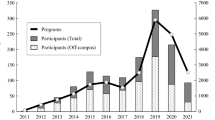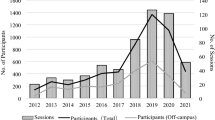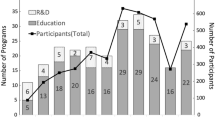Abstract
The contents and conflicts of interest of Cadaver Surgical Training (CST) programs in Japan were reported to the Japan Surgical Society CST Promotion Committee based on professional autonomy. After receiving the reports from participating universities, the committee evaluated the validity of these reports and provided advice on the proper implementation of CST. Over the past decade, 38 universities have been using cadavers for clinical education and research, such as CST. If inappropriate entries or unclear areas were identified, the universities could be asked to resubmit their report. This review clarifies the evaluation points of the CST reporting system, shows the status and problems of its reporting, and provides suggestions for the dissemination of CST in the future.
Similar content being viewed by others
Avoid common mistakes on your manuscript.
Introduction
The “Guidelines for Cadaver Dissection in Education and Research of Clinical Medicine,” jointly published by the Japan Surgical Society and the Japanese Association of Anatomists in 2012, is intended to facilitate cadaver use in education and research on clinical medicine, by reinforcing the Act on Body Donation for Medical and Dental Education and the Postmortem Examination and Corpse Preservation Act. Over the last decade, Cadaver Surgical Training (CST) programs in Japan have been implemented in compliance with guidelines established voluntarily by academia, and clinical research and the development of medical devices using cadavers have been pursued [1]. Considering the historical and legal differences between Japan and other countries [2], the guidelines have the following requirements for implementation:
-
(1)
Their purpose should be to improve medical safety and contribute to public welfare.
-
(2)
Programs must be part of university education and research and in compliance with the Act on Body Donation for Medical and Dental Education and the Act on Postmortem Examination and Corpse Preservation.
-
(3)
When cadavers are used for clinical medical education and research, written and advance consent should be obtained from the deceased prior to their death. Furthermore, consent must be obtained from their family.
-
(4)
The implementation must be approved by an ethics committee.
Entities that implement CST programs are obliged to submit reports based on professional autonomy. Reports on the implementation content and conflicts of interest (COI) are submitted to the Japan Surgical Society CST Promotion Committee.
Overviews of CST reports from medical universities in Japan
The Japan Surgical Society organized a Guidelines Review Committee (later renamed CST Promotion Committee) in 2012 to receive and process reports from universities, evaluate their validity, and provide advice on the proper implementation of CST (Table 1).
Over the past decade, 38 universities have used cadavers for clinical education and research, such as CST, and have submitted their reports to the CST Promotion Committee. The committee established standards based on the guidelines and evaluated each report for its objectives, content, usefulness, ethics, and COI (Table 2). If inappropriate descriptions or unclear expressions were identified, the committee requested the university to resubmit the report with a detailed explanation. Table 1 shows that more deficiencies are being identified as the number of reports increases. Soon after the guidelines were published, universities initiated CST programs by trial and error, and many problems required appropriate guidance, such as deficiencies in the implementation system or mistakes in the COI descriptions. However, recent reports posted to the implementation system show fewer deficiencies than those in the initial years. In 2021, 25 reports required resubmission, for the following reasons, as summarized in Table 2: In four reports, the description of "the representative of the practice" in "item 2″ was inappropriate. The respective universities were advised to "make sure that the representative person in charge of implementation is a professor or associate professor in a clinical department and that the supervisor is a professor or associate professor in a department of anatomy”. In two reports, item 6 was questioned and the respective universities were advised as follows: "In the section on operating costs, when examining the entries under ‘expenses’, check for extremely high tuition fees, participation fees, social gathering fees, or instructor fees". In addition, there were 21 typos (9 miswriting errors, 6 omissions, and 6 calculation errors, including duplicates).
Aspects of the assessment of CST reports from various surgical fields
In addition to the representatives from the Japan Surgical Society and Japanese Association of Anatomists, the CST Promotion Committee that conducted these assessments included one member each from the Japanese Orthopedic Association, the Japan Neurosurgical Society, the Japanese Society of Otorhinolaryngology-Head and Neck Surgery, the Japanese Society of Oral and Maxillofacial Surgeons, the Japanese Urological Association, the Japan Society of Obstetrics and Gynecology, and the Japanese Society of Anesthesiologists. The members examined the deficiencies in the reports from a professional standpoint, whether the objectives of the CST or other programs would broadly contribute to medicine development, whether the content would be suited to the objectives, and whether the program would be useful.
The Japan Surgical Society was involved in the reporting system from the establishment; hence, reports in the field of surgery could be evaluated appropriately by multiple members. However, for other specialized fields, the assessments relied on the views of only one committee member. Notably, there has been a dramatic increase in reports in the fields of orthopedic surgery, neurosurgery, and otorhinolaryngology [3] (Fig. 1), and the representatives from these fields have had trouble responding. Currently, it is difficult for one evaluator to address these fields. From an international perspective, there are also otolaryngology fields where the importance of CST research is emphasized even in the current COVID-19 pandemic [4]. Reports on medical device development in the neurosurgery field indicate delays in Japan [5]. Based on these revelations, we believe that core academic societies in each field should be responsible for reviewing the implementation status of CST and R and D, and that each academic society should respond to inappropriate implementations.
Establishment of a working group and four proposals for all CST in Japan
In 2021, the CST Promotion Committee organized a working group under a Ministry of Health, Labor and Welfare project on regional medical infrastructure research and development (“Research on promoting the dissemination of effective medical technology educational system using donated bodies”; Chief Investigator, Hiroshi Date of the Japan Surgical Society’s CST Promotion Committee). This group includes leading figures in CST from the fields of orthopedic surgery, neurosurgery, and otolaryngology. The group is now studying how to promote the appropriate use of cadavers in all clinical fields, not only for surgical training, but also for the development of medical devices. Recently, the working group established the following proposals to stakeholders (academic societies, governments, businesses, and citizens) to develop clinical medicine through education and research using donated cadavers appropriately.
-
(1)
To improve the current reporting system through its optimization, so that each academic society can evaluate implementation programs and provide guidance.
-
(2)
To strengthen professional autonomy by offering seminars at conferences of each academic society to disseminate rules on implementation.
-
(3)
To prepare new guidelines and recommendations: The working group propose to work with academic societies to prepare new guidelines on items of shared interest, including the implementation of guidelines for medical device development, and accept recommendations for academic societies by the fields that align with the new guidelines.
-
(4)
To promote activities to gain public acceptance of the appropriate use of cadavers for clinical medicine by providing materials that review the historical background and status quo of CST in Japan.
The activities of academia are indispensable for creating an autopsy system that uses donated bodies in medical education and will not incite scandals such as those that have occurred in other countries [6]. This working group acts jointly with the Japan Surgical Society’s CST Promotion Committee. Additionally, we have received advice on future prospects from Dr. Morito Monden, Japanese Medical Science Federation Chairman, and from Dr. Masaki Mori, Japan Surgical Society President.
Abbreviations
- CST:
-
Cadaver surgical training
- ICU:
-
Intensive care unit
References
Shichinohe T, Kobayashi E. Cadaver surgical training in Japan: its past, present, and ideal future perspectives. Surg Today. 2022;52:354–8.
Kobayashi E, Nudeshima J. Current state of surgical training using cadavers in Japan compared with Western countries. Surg Today. 2018;48:891–3.
Shichinohe T, Date H, Hirano S, Kobayashi E, Izawa Y, Shirakawa Y, et al. Usage of cadavers in surgical training and research in Japan over the past decade. Anat Sci Int. 2022;5:1–10.
Kobayashi E, Shichinohe T, Suzuki T. Cadaver surgical education and research under the SARS-CoV-2 pandemic in Japan. Otolaryngol Head Neck Surg. 2022;166:1003–4.
Araki Y, Shichinohe T, Suzuki T, Kobayashi E. Obstacles to cadaver use for the development of neurosurgical techniques and devices in Japan. Neurosurg Rev. 2022;45:2489–91.
Nudeshima J, Kobayashi E. Considering respect for the donated body: lessons from the scandal in France. Anat Sci Int. 2022. https://doi.org/10.1007/s12565-022-00654-x.
Acknowledgements
CST reports received from universities since the publication of the guidelines are attributed to the efforts of the Guideline Review Committee, followed by the CST Promotion Committee. 2012 Guideline Review Committee: Takashi Kondo, Yoshiro Matsui, Yoshimitsu Izawa, Chizuka Ide, Toshihiko Iwanaga, Yasuo Uchiyama, Akio Kikuta, Eiji Kobayashi, Toshiaki Shichinohe, Yutaka Nohara, Kazunari Yoshida. 2018 CST Promotion Committee: Hiroshi Date, Satoshi Hirano, Yoshimitsu Izawa, Eiji Kobayashi, Toshiaki Shichinohe, Yasuhiro Shirakawa, Masako Hiramatsu, Kazunari Yoshida, Hiroshi Taneichi, Hiroyuki Yaginuma, Yasuo Uchiyama, Toshiyuki Tsurumoto, Masahiko Watanabe, Takanori Shibata, Haruo Takahashi, Takane Suzuki, Kumiko Yamaguchi. Finally, we thank Takahiro Uesawa and Kentaro Kaneko of the Japan Surgical Society secretariat for their years of work in the CST reporting office.
Author information
Authors and Affiliations
Corresponding author
Ethics declarations
Conflict of interest
We have no conflicts of interest to declare.
Additional information
Publisher's Note
Springer Nature remains neutral with regard to jurisdictional claims in published maps and institutional affiliations.
Rights and permissions
About this article
Cite this article
Kobayashi, E., Shichinohe, T. Assessment of reports on cadaver surgical training (CST) implementation in Japan: current status and challenges. Surg Today 53, 749–752 (2023). https://doi.org/10.1007/s00595-022-02554-z
Received:
Accepted:
Published:
Issue Date:
DOI: https://doi.org/10.1007/s00595-022-02554-z





